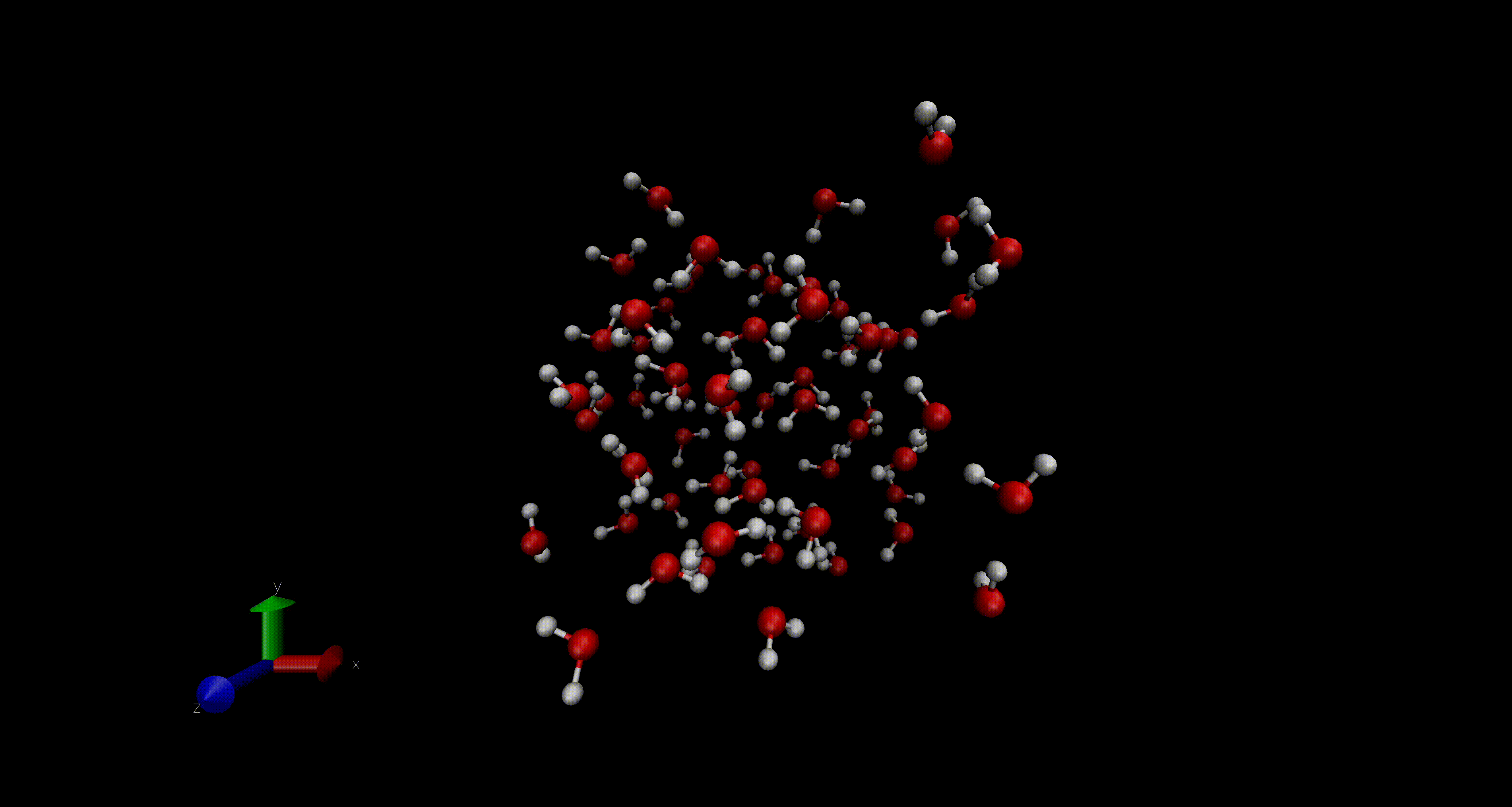This guide will walk you through setting up and running CP2K simulations using the Inductiva API.
CP2K#
CP2K is an open-source quantum chemistry and solid-state physics software designed for atomistic simulations. It supports a wide range of methods, including Density Functional Theory (DFT), semi-empirical and classical force fields, making it suitable for molecular dynamics, electronic structure calculations, and materials science applications. Its flexibility and extensive features make it a powerful tool for researchers in computational chemistry, condensed matter physics, and related fields.
Supported Versions#
We currently support the following CP2K version:
v2025.1 - Compiled with AVX2 and GPU support
Running the CP2K H2O-64 Benchmark#

Objective#
This tutorial will show you how to run a CP2K simulation using the H20-64 benchmark available on the official CP2K website. This use case simulates a system containing 64 water molecules (192 atoms, 512 electrons) in a 12.4 ų cell, with MD running for 10 steps.
We will also demonstrate Inductiva’s ability to efficiently scale this use case on a more powerful machine.
Prerequisites#
To follow this tutorial, download the input file for the H2O-64 benchmark from
here and
place it in a folder called H2O-64. Once you have the simulation file, you’re
ready to scale your simulations to the Cloud.
Running Your Simulation#
Here is the code required to run a CP2K simulation using the Inductiva API.
In this example, we will execute the simulation on a virtual machine with 16 vCPUs, supported by a 4th generation AMD EPYC™ (Genoa) processor.
"""CP2K Simulation."""
import inductiva
# Allocate a machine on Google Cloud Platform
cloud_machine = inductiva.resources.MachineGroup(
provider="GCP",
machine_type="c3d-highcpu-16")
# Initialize the Simulator
cp2k = inductiva.simulators.CP2K(
version="2025.1")
# Run simulation
task = cp2k.run(
input_dir="/Path/to/H2O-64",
sim_config_filename="H2O-64.inp",
on=cloud_machine)
task.wait()
cloud_machine.terminate()
task.download_outputs()
task.print_summary()
To adapt this script for other CP2K simulations, replace input_dir with the
path to your CP2K input files and set the sim_config_filename accordingly.
Once the simulation is complete, we terminate the machine, download the results, and print a summary of the simulation as shown below.
inductiva tasks info 7y33ri1umg0tsppabxf5jska4
Task status: Success
Timeline:
Waiting for Input at 05/03, 16:04:17 1.525 s
In Queue at 05/03, 16:04:19 21.308 s
Preparing to Compute at 05/03, 16:04:40 8.307 s
In Progress at 05/03, 16:04:48 103.301 s
└> 103.177 s /opt/openmpi/5.0.6/bin/mpirun --use-hwthread-cpus --np 16 cp2k.psmp H2O-64.inp
Finalizing at 05/03, 16:06:32 0.453 s
Success at 05/03, 16:06:32
Data:
Size of zipped output: 87.62 KB
Size of unzipped output: 296.14 KB
Number of output files: 6
Estimated computation cost (US$): 0.0049 US$
Go to https://console.inductiva.ai/tasks/7y33ri1umg0tsppabxf5jska4 for more details.
The core computation time for this simulation was approximately 1 minute and 43 seconds
(103 seconds), as shown in the In Progress line. This represents the
actual execution time of the CP2K benchmark on a 16 virtual CPU machine.
For comparison, the same simulation takes 1 minute and 15 seconds on a similar local machine with a 16 virtual CPUs (Ryzen 7 7700X). This performance difference is expected, as cloud CPUs typically have lower clock speeds compared to regular desktop processors, prioritizing energy efficiency and density over raw speed.
However, increasing the number of vCPUs on the cloud machine could enhance performance.
Scaling Up Your Simulation#
With the Inductiva API, scaling up your CP2K simulation is as simple as changing two parameters:
Modify the
machine_typeto a more powerful machine with more vCPUs.Adjust the
n_vcpusaccordingly to maximize parallel processing efficiency.
As mentioned above, running this simulation on a 16 vCPU cloud machine was slower than on a similarly powered local computer. To enhance performance, we upgraded to a c3d-highcpu-60 instance with 60 vCPUs, reducing the runtime to just 38 seconds—with a slight cost increase to $0.0077.
Machine Type |
Virtual CPUs |
Time |
Estimated Cost |
|---|---|---|---|
Local Ryzen 7 7700X |
16 |
1 minute and 15 seconds |
N/A |
Cloud c3d-highcpu-16 |
16 |
1 minute and 43 seconds |
0.0049 US$ |
Cloud c3d-highcpu-60 |
60 |
38 seconds |
0.0077 US$ |
By leveraging the Inductiva API, you can efficiently scale your CP2K simulations to meet your computational needs. Try different machine configurations and optimize your workflow for faster, more cost-effective results!